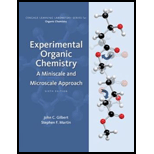
a)
Interpretation:Whether compounds with zero
Concept introduction: TLC or thin layer chromatography is technique that is used to separate various components of mixture with help of stationary phase and mobile phase. It makes use of silica gel, cellulose or aluminum oxide. This procedure is widely used because of its simplicity, low cost efficiency, and high sensitivity.
Retention factor or
b)
Interpretation:Step that can be done to get nonzero value of
Concept introduction: TLC or thin layer chromatography is technique that is used to separate various components of mixture with help of stationary phase and mobile phase. It makes use of silica gel, cellulose or aluminum oxide. This procedure is widely used because of its simplicity, low cost efficiency and high sensitivity.
Retention factor or
Want to see the full answer?
Check out a sample textbook solution
Chapter 3 Solutions
Experimental Organic Chemistry: A Miniscale & Microscale Approach (Cengage Learning Laboratory Series for Organic Chemistry)
- how does TLC determine if a sample is pure?arrow_forwardThere were 2 spots on the TLC that did not match up with any of the standards. What were the Rf values of these spots? Identify what these chemical species might be and draw their structures. Solvent was 3:1:1 n-butanol/acetic acid/water. First plate is TLC plate 1. Second plate is TLC plate 2.arrow_forwardCI NH 'N' chloroquine CI NH LHO N. N: hydroxychloroquine 5. You attempted to separate chloroquine and hydroxychloroquine using paper chromatography. You used a mixture of benzene and pyridine as your solvent. What results can you expect? O Two bands: hydroxychloroquine will have a higher Rf than chloroquine One band: Both will have equal Rf Four bands: The enantiomers of each analyte will appear as separate bands Two bands: chloroquine will have a higher Rf than hydroxychloroquinearrow_forward
- If you run a compound on 4 different TLC plates using the following four different solvent systems which solvent system would give the largest Rf value for the compound?arrow_forwardWhat is the purpose of chemically staining a TLC plate using iodine vapor? To increase the Rf values of all compounds on the plate To decrease the Rf values of all compounds on the plate To visualize colorless compounds that react with iodine on the plate To spread out the Rf values of all compounds on the plate morearrow_forwardQs4. This is a TLC analysis of 3 individual compounds. The plate was run in 20 % ethyl acetate, 80% hexane solvent mixture (eluent). Draw a schematic TLC plate for the same compounds, but when the eluent is 40% ethyl acetate, 60 % hexane. Indicate, what is the most polar and least polar compound (A, B, or C) -- A B Carrow_forward
- Consider a sample that is a mixture composed of biphenyl, benzoic acid, and benzyl alcohol. The sample is spotted on a TLC plate and developed in a CH2C12-cyclohexane solvent mixture. Predict the relative Rf values for the three components in the sample. Would biphenyl be closest to the blotted line, then benzyl alcohol, then benzoic acid because these others are increasing in polarity to the non-polar solvent? Thanks!arrow_forwardThe TLC plate shown was run in 80:20 Petroleum Ether - Ethyl acetate. If the eluent is changed to 95:5 Petroleum Ether - Ethyl Acetate, what will happen to the R-values? All Rf values will decrease All Rf values will increase Some Rf values will increase Some Rf values will decreasearrow_forwardIn TLC, why does the developing solvent 3:1:1 n-butanol/acetic acid/water climb up the TLC plate so slowly?arrow_forward
- Arrange the following solvents in order of increasing polarity (least polar to most polar): Propyl Amine – Diethyl Ether – Ethyl Acetate- Octane If you ran an unknown sample on a TLC and observed only one spot with a Rf value of 0.95, is it safe to assume that it is a pure compound? If not, how can you check it out using TLC?arrow_forwardDid you see any components that didn’t match the reference compounds? How do you know? If you didn’t see any extra components in the sample, what would you expect to see on the TLC plate if there were extra components?arrow_forward1. Answer true or false for each statement: a) A TLC analysis is sufficient to characterize the purity of a compound. b) Carboxylic acids containing six or more carbon atoms per molecule are more soluble in2.5 M sodium hydroxide than in diethyl ether. c) Phenols containing six or more carbon atoms per molecule are more soluble in 2.5 M sodium hydroxidethan in diethyl ether. d) Benzoic acid and p-nitroaniline form water-soluble salts, whereas naphthalene does not. e) TLC analysis is the method of choice to determine the type of solid phase and eluent system that is required for a column chromatography separation. f) Mineral oil is an inappropriate heating fluid for determining the boiling points of samples that exceed 200°C (760 torr)? g) A heating bath containing mineral oil should not be used to determine the melting points of solids meltingabove 200 °Carrow_forward
 EBK A SMALL SCALE APPROACH TO ORGANIC LChemistryISBN:9781305446021Author:LampmanPublisher:CENGAGE LEARNING - CONSIGNMENT
EBK A SMALL SCALE APPROACH TO ORGANIC LChemistryISBN:9781305446021Author:LampmanPublisher:CENGAGE LEARNING - CONSIGNMENT
